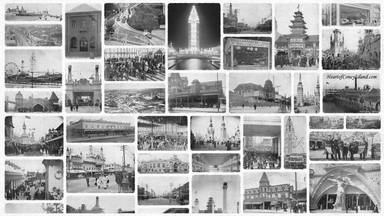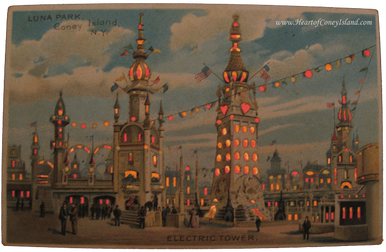The Comprehensive History of Coney Island
I. The Five-Minute History Crash CourseA useful framework for cramming 150 years of history into 5 minutes.
"Who remembers the Coney Island of 40 years ago?" People nowadays are nostalgic for the Coney Island they knew growing up. But what if I told you this quote was the title of a 'letter to the editor' in a newspaper published in 1933? Read about Coney Island's evolution over seven major historical periods from 1870 to today. |
II. 'BluePrint: Coney Island' DocumentaryA great 30-minute documentary on the Coney Island of today and yesterday.
NYC Media, the official broadcast network and media production group of the City of New York, prepared a very insightful and thoroughly-researched documentary film on Coney Island's development. This film captures the essence of Coney Island through numerous interviews, some rarely-seen video footage, and a plethora of photographs from both public and private collections. |
III. Early History (1600-1870)Read these if you're a researcher or hardcore enthusiast; else, go to IV & V.
When the Dutch first arrived in the early 1600s, Coney Island’s geography was quite different than it is today. The original ‘Conyne Eylandt’ was just the westernmost one-mile tip of today’s Coney Island. The first article tells the comprehensive story of early Coney Island, from its initial settlement by the Dutch to the start of the American Civil War. The second is a famous story of mutineers who came ashore at Manhattan Beach in 1830. |
IV. The Seaside Resort Era (c. 1870-1900)The feature article on How West Brighton became 'Coney Island' and its companion articles on Brighton Beach and Manhattan Beach cover the comprehensive history of Coney Island using many rare photographs.
Coney Island transformed rapidly during the 1870s, shortly after the Civil War. New railroads brought visitors in far greater numbers than ever before, increasing the demand for hotels, restaurants and entertainment. At the time, Coney Island was split into three competing, adjacent seaside resorts: West Brighton, Brighton Beach and Manhattan Beach. West Brighton appealed to the working and middle classes, Brighton Beach to the upper-middle class, and Manhattan Beach to wealthy socialites. West Brighton was backed by two railroad syndicates, one led by Andrew Culver, and the other named the Sea Beach Company. Brighton Beach was backed by a wealthy businessman named Bill Engeman, as well as by a railroad company known as the Brighton Line. Manhattan Beach was controlled by a ruthless robber baron named Austin Corbin. Eventually, most of Coney Island came to be controlled by John Y. McKane, an ambitious carpenter who gained political power by trading favors for kickbacks to his personal construction company. The heyday of Coney Island as a renowned seaside resort lasted from roughly 1880 to 1900. During this time, the resorts and racetracks at Manhattan Beach and Brighton Beach drew massive crowds. West Brighton would soon eclipse them, however, when Luna Park opened in 1903 and ushered in the golden age of the amusement park. These articles tell the comprehensive story of the contest between West Brighton, Brighton Beach and Manhattan Beach between 1870 and 1920. |
V. The Iconic Amusement Park Era (c. 1895-1915)These four articles will turn you into an amusement park history genius. The article on Sea Lion Park is very popular. The Dreamland article presents a totally new take on Reynolds and the Dreamland Fire.
West Brighton was home to some of the world's most iconic amusement parks. Sea Lion Park opened in 1895 and pioneered the concept of charging admission to an enclosed park. Steeplechase Park followed in 1897. The legendary Luna Park opened in 1903 on the prior site of Sea Lion Park, and its innovative design revolutionized the concept of what amusement parks could offer. Dreamland opened the following year. These parks made Coney Island famous around the world. The history of these parks is completely interwoven. While each park had its own unique character and business model, they all competed for the best rides, shows and staff, and constantly tried out new ideas. People were drawn by bands, dancing, dining, circus and daredevil acts, carnival games, roaming elephants and even the chance to see real Eskimos. |
VI. Annotated Historical Maps (1879, 1905)The most comprehensive map of Coney Island during its Amusement Park Era.
I spent a few months researching and identifying almost 200 different rides, hotels, restaurants, hotels and streets on a map from 1907. It was recently published in Katharine Harmon's book, "You are Here: NYC (Mapping the Soul of the City)." Also included is a map of Culver Plaza from 1879, as well as a bird's-eye view from 1905. Enjoy! |
VII. Roller Coasters, Shows & Attractions (c. 1905)A beautiful collection of rare ride tickets and well-researched analysis.
Dozens of roller coasters, extravagant shows and rides operated within and outside of Coney Island's three major amusement parks in the early 1900s. This page provides detailed descriptions of these rides by showcasing a large collection of rare and beautifully-designed tickets. The tickets were printed in a manual, multi-step lithographic process. The tickets doubled as advertisements because customers would fasten them to buttons to wear during the day, and took them home as keepsakes for scrapbooking. |
VIII. Doctored Images and Photograph GalleryEdwardian 'Photoshopping' at its finest... look closer!
View a collection of rare historical photographs with scenes and buildings from all over Coney Island. This page also includes examples of 'Edwardian Photoshopping', where entire people or objects have been inserted or removed in images, day has been changed to night, and many other tricks are used by early printers to make the photo look just right. |
IX. Koehler Hold-to-Lights Postcards (c. 1905)Let's just say that they don't make postcards like they used to.
Postcards took off in the US in the early 1900s and a craze soon took hold. With mail being delivered multiple times a day, postcards became the email messages of 100 year ago. But just how much can you trust postcards as historical sources? After you've seen a few thousand of Coney Island, you start to notice some strange things. Check out some interesting facts about postcards in this article. Also included is the complete set of Coney Island Koehler hold-to-light postcards made circa 1906, some of the finest and rarest postcards ever produced. |
X. Steamboats to Coney Island (1880s)A collection of humorous (and racy!) steamboat advertisements.
Traveling by steamboat was the fastest way to get to Coney Island from Manhattan in the late 1800s. It was also fun - many steamboats had their own band! You could, alternatively, also take one of several railroads, or even a horse-drawn carriage taxi. Check out some of the steamboat advertisements of the era. These 'trade cards', as they were called, measured roughly 3.5" by 5.5". They had a picture on the front and some practical information, like a schedule or map, on the back. |
XI. A Trip through Coney Island in 1880Dating to 1880, this game is among the most informative and unique pieces of Coney Island ephemera from early in Coney Island's Seaside Resort Era.
This incredible early Milton Bradley word game tells the story of a group of six friends who take a daytrip to Coney Island. They take a steamboat on the way out and on a railroad on the way back, visiting all of the sights along the way at West Brighton, Brighton Beach and Manhattan Beach. |
XII. Jumbo the Elephant at Coney Island (c. 1883)Why is Jumbo wearing a full-body swimsuit and hat at the beach?
Jumbo was so popular in the mid-1880s that even after he died in 1885, Barnum's circus continued to draw large crowds by touring Jumbo's skeleton. Originally called Mumbo Jumbo, he was a gentle giant, the largest elephant in captivity, and the reason that today the word 'jumbo' means 'extra-large'. These Victorian trade cards were printed at the peak of Jumbo's popularity and are great examples of Victorian humor. |
Heart of Coney Island actively purchases Coney Island memorabilia. Please feel free to contact me for more information.
The primary focus is on memorabilia dating to between 1850 and 1920, including advertisements, posters, scrapbooks, menus, diaries and letters, full-size carousel figures, objects and artifacts, blueprints, ride drawings, and original photographs.
The primary focus is on memorabilia dating to between 1850 and 1920, including advertisements, posters, scrapbooks, menus, diaries and letters, full-size carousel figures, objects and artifacts, blueprints, ride drawings, and original photographs.
All images and text on this site are the author's intellectual property and are copyrighted by the author, unless noted otherwise. All images are scans from the author's collection of historical New York City documents, unless otherwise noted. Academic and non-profit use, and linking content to other websites for non-commercial purposes, is encouraged under the condition that standard academic best practices are used to source/attribute the intellectual property. Commercial use of high-resolution images is available under written licensing agreements.
























